
Lots
of boats come to Oriental, some tie up at the Town Dock for
a night or two, others drop anchor in the harbor for a while.
If you've spent any time on the water you know that every boat
has a story. The Shipping News on TownDock.net brings you the
stories of the boats that have visited recently.
Tuesday, August 24, 2004
Felicity
It was, Jason Foote allows, “ a sad sight to see.” His Dyer dinghy, was tied near his Alberg 30 and the Town Dock bulkhead during Hurricane Charley and it was full of water. Not just a little water covering the bottom, but almost right up to the brim.
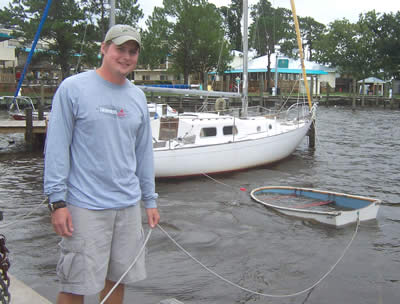
But things aren’t always as they seem. In this case, it wasn’t Hurricane Charley’s winds and rain that filled the dinghy. It was Jason himself, on his father’s advice, who did it. Jason says they figured that the dinghy would have “so much windage” once the hurricane came that it might separate from the lines to the boat and slam down on the concrete of the bulkhead.
And so, Jason intentionally let the water in --- “we almost flipped it over” – so that the little dinghy rode low – very low – in the water.
The Alberg 30 that goes with that dinghy has been Jason’s home on and off for the past 7 years. He became a liveaboard when he got out of college and was working in Washington, DC. He says he was “not excited about the idea of having 10 roommates” in order to afford the rent. He knew some people who were living at Gangplank Marina off the Potomac. He joined them by buying the Alberg for about the cost of a year’s rent. “I paid more for my car!” he says, adding that he’d "throw the car to the wolves" before he would the boat.
The Alberg was built in 1975 and one only one couple owned it before Jason. The name "Felicity" and the "sunshine yellow" canvas came with the boat. (Jason says he gets “more comments” from people who recall passing his boat in an anchorage or on the waterway, because they don’t see that canvas color very often.)
He keeps “Felicity” in Annapolis now – where the sailing is better than it is on the Potomac -- and commutes to Capitol Hill where he works, “doing research for a lobbyist”. The work allows him to take off time to go sailing. This past winter he sailed to the Bahamas and for the past six months he’s been in Charleston, SC.
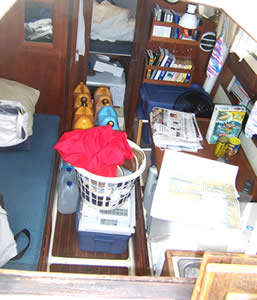
Preparing for a hurricane can lead to a crowded boat down below |
Which is where he was when Hurricane Alex approached in the first week of August. Jason says he took that as a sign that he should get the boat to its home port in Annapolis. He pointed north. His sister Heather, who just graduated college, got on board in Wrightsville Beach for the trip.
They hadn’t gotten very far before they were joined by some other northbound travelers named Bonnie and Charley. Heather and Jason brought “Felicity” in to the Oriental Marina for a few days. But then as Charley neared, Jason says the marina asked the boats to leave. Fortunately for him there was a space at the Town Dock.
On the Saturday morning before Charley, Jason was prepping his boat. He tightened the roller furling, removed his main sail, tied off his boat at an angle from the Town Dock. And of course he filled that dinghy with water as his father suggested.
His father was on hand to offer advice because Jason’s parents drove down from Annapolis Saturday to pick up Heather who had to be in Annapolis Monday. From a room at the Oriental Marina Inn they watched the storm from a variety of perspectives – out the window, on line at TownDock.net, and going down to the boat now and again to be sure the lines held.
The lines did. “Felicity” rode out the storm well, tucked in behind two steel trawlers from Garland Fulcher Seafood. “It was perfect,” Jason says, recalling that the harbor in general was protected from most of the winds. He says it was like having your “own little hurricane hole.” Jason was thankful there was no storm surge (as in Isabel) that would have made “toast” of his boat by putting it up on the concrete bulkhead.
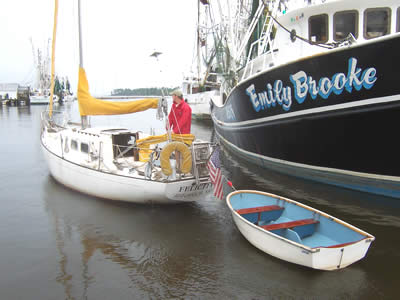
On Sunday morning, with the mainsail on the boom again, the yellow sail cover back in place, and copies of the Sunday Washington Post and the New York Times down below (he’s had a hard time finding either on the ICW) Jason took off from the Town Dock, bound once again for Annapolis.
posted 8/24/2004 12:32:00 PM
Thursday, August 12, 2004
Seaventure
The teal hull stood out on the Krogan 38 that was tied to the Town Dock. Jack Silcox says that it stood out to him too when he first saw the centerboard cruiser for sale at a Fort Myers marina in 1996. “I thought, ‘What a strange color for a boat.'”
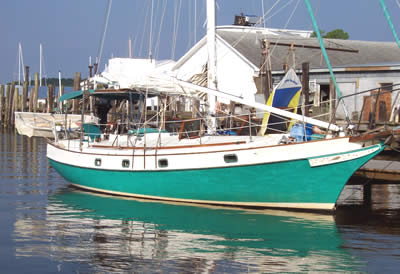
Carol Silcox says that when they sailed "Seaventure" in the Bahamas last summer, they found waters that matched the boat paint, and it looked as though the boat and the water were one.
Last summer’s trip to the Bahamas on the centerboard sailboat had been a shakedown cruise of sorts. While Jack had owned and sailed the boat for several years, he and Carol had only met in the fall of 2002. They both were New Jersey transplants in Florida and both had spent time around boats. Jack was partial to cruising style boats; Carol’s experience was racing boats. As a girl she raced on prams in NJ.
Last summer, Jack and Carol took off for the Bahamas to see how Carol might take to living on the boat.
It was a success.
They got married in November.
A month later, Carol quit her job as a guidance counselor. Jack talked her in to it with the question, “Do you want to work, or do you want to go cruising?”
They set out from Florida earlier this year and headed north. They sailed to the Chesapeake; in Annapolis they saw the beginning of the Annapolis to Bermuda race. From there, they “sailed places we’d sailed when we didn’t know each other” – the NJ coast, Long Island Sound. They went as far as Newport and caught the Tall Ships there.
Asked if she missed the guidance counseling work, Carol quickly says, “I don’t even remember doing it.”
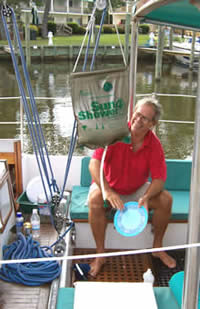
Life onboard sometimes includes doing the dishes in the cockpit - hot water via sun shower. |
Yet as much as they liked the last few months on board “Seaventure” Carol and Jack were working their way back to their home in Hobe Sound, Florida.
“I like home,” Jack says. Carol also speaks of having a ‘nest’ on land. They don’t want to go cruising full time but may take off “to knock around” the Bahamas for a few months now and again.
For that kind of sailing, in often shallow Bahamian waters, Jack says he likes the Krogan’s 3-1/2 foot draft. As for its handling elsewhere, Jack allows that, “it’s not that fast around the marks.” The shallow keel boat weighs 28,000 lbs. But the Krogan does have a centerboard, and an aft-trim board as well, which he says he drops down when “Seaventure” encounters too much weather helm. “Then," Jack says, "it goes away.”
Jack bought the boat as a “handyman’s special”. A retired doctor from the upper Midwest had owned it previously. “He’d read too many Cruising World's,” Jack says, “and spent a lot of money” to be a part of the sailing scene. Jack says that the doctor kept the boat in west Florida and just took it on, “one trip. To Annapolis. I think he motored up the Inter Coastal.” Then Jack says, the doctor put the boat up for sale in a Fort Myers marina, which is where Jack first saw the bright blue-green hull. While Jack says the color “turned me off” at first sight, 8 years later, he hasn’t changed the paint.
“Seaventure”s teal hull may not be at the Town Dock again for a long while, although the Silcox’s say they may again visit Oriental by land.
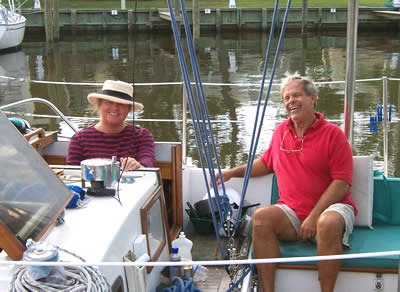
Jack noted that he’s seen people say hello to strangers they pass on the streets of other towns. He saw it in NJ growing up. But, he adds, Oriental went a step beyond that. “I never saw people who were passing in their cars stopping to say hello.”
posted 8/12/2004 08:55:00 AM
Tuesday, August 10, 2004
Holo Holo
Before airplanes shortened the distances between South Pacific islands, Pat Fox hopped from island to island on board schooners. In the late 1950's she had just finished school in Hawaii and wanted to begin traveling. For five years, that’s what she did, virtually thumbing her way back and forth between Hawaii and Australia.
She recalls crew having to skinny up the mast to sight coral atolls. And multi-colored pearls. And sleeping on decks of ships that delivered sheep to some islands. Sleeping on deck was a way to get cheap passage, she says, and sacks of coconut - called copra sacks - provided a mattress. “They carried bits of dried coconut and there were jillions of copra beetles.” Still Pat says, “it’s such a precious memory”
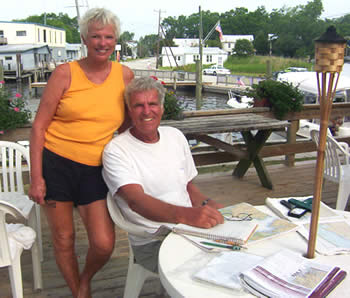
Pat talked about those times recently while on board a decidedly smaller, but happily beetle-less vessel. Pat and her friend Gene Grounds stopped in at the Oriental Marina in June, on board Gene’s Farrier24 trimaran. Some of that spirit from Pat’s schooner days endures.
The tri’s name is “ Holo Holo,” Gene says it means “traveling all around” in Hawaiian, which describes what they and the boat do.
Gene and Pat met 6 years ago when he was looking for crew for a charter he had arranged in Turkey. He needed ‘somebody who could sail anywhere.” A friend put him in touch with Pat. He says he figured her background in the Peace Corps in Africa (where she went after her South Pacific adventures) meant that she could handle anything.
They’ve been taking sailing trips ever since.
Gene lives in Hawaii where he’s retired from banking. Pat is an artist who lives in California. After sailing together in Turkey, he says, he decided that he had to “have a boat that I could sail over here (off the Mainland US) and play with."
He’d always owned multihulls and found the Farrier24 in Charlotte. His idea was to keep in on a trailer in California and venture out from there, with Pat on trips on either coast. (Although the boat has a boat registration that begins with HA -- rarer, we think than a Hawaii licencse plate here -- "Holo Holo" has not gone "Holo Holo" in Hawaii.)
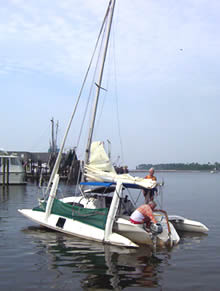
Holo Holo in slip spacesaver mode - one hull "folded" |
One of their first extended cruises on “Holo Holo” was to the San Juan Islands in the late summer of 2001. Pat and Gene launched the boat on September 11th, not paying much attention to the news report they heard in the motel room TV about a plane and the World Trade Center. They took off on their trip, disconnected from media reports for days before realizing what had happened.
This year, they had planned to sail “Holo Holo” near those waters off the Twin Towers, their sights set on the Statue of Liberty. They trailered the boat across the country to Florida, where Gene competed in a trimaran race in the spring. Then they began making their way up the coast, which is what brought them to Oriental. Running behind schedule the two were thinking they’d cut the trip short in July because of some responsibilities back home. They hoped to get as far as the Chesapeake.
This has been Gene’s first time sailing on the East Coast and he finds the sailing different. In Hawaii he says, it’s “extreme sailing” with winds “blowing half again as fast as here. Palms are swaying. And there are great big swells that come from so far away.” As such, he notes, the masts on sailboats there tend to be 5-6 feet lower.
Coming from Hawaii and the west coast, Gene says he didn’t know much about the ICW before he got on it in Fort Lauderdale. He says he’s managed to sail most of the way, even in the narrow channels.
Going as fast as he'd like however has eluded him. Gene, who grew up surfing in California, likes speed, noting that he’s gotten the little trimaran to do 20 knots in Southern California waters. Doing 5.4 knots, he says, is “like bleeding to death slowly. “Where are my wrists?’”
That desire for speed spills over to his approach to cruising. He likes to stay a day, 'two max' in towns and move on.
The F24Corsair's two side hulls, called ‘amas’ can hinge up, allowing the crew of “Holo Holo” to reduce her 14’ beam so that it can fit in to slips. One of the amas was up at Oriental Marina. The other provided a platform for some storage, including Gene’s surfboard, which owing to its boogie board material, he had named “Spongebob”
The accommodations are austere on “Holo Holo” Pat’s no longer dealing with swarming copra beetles or sleeping on deck as she did four and a half decades ago on the schooners. But she notes that on the trimaran there is “zero space. In order to lie down at night," she says, "you have to move the bike first and an enormous bag holding the screecher sail, the spinnaker…” The plate and cups are stored in a cockpit locker.
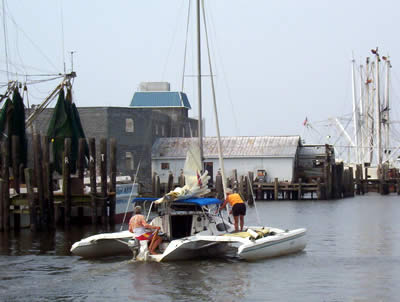
But like the schooner in the late fifties, the trimaran is taking her places and reminding her of the South Pacific days.. And together she and Gene go “Holo Holo”
posted 8/10/2004 09:18:00 AM
|
If
you have news of a boat -- sail boat, trawler, kayak, anything that
floats -- that's come to Oriental, drop us a line here at news@towndock.net
|
|









